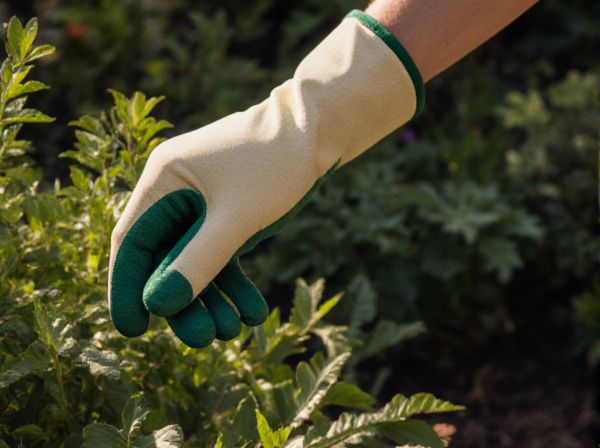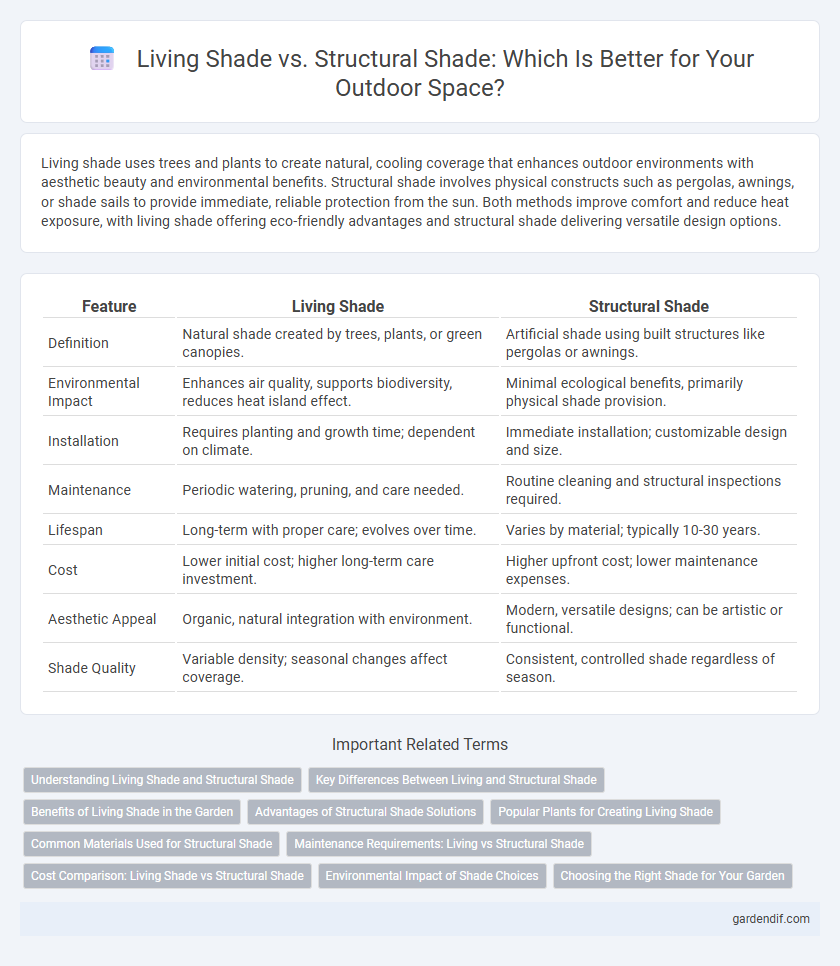
Living Shade vs Structural Shade Illustration
Living shade uses trees and plants to create natural, cooling coverage that enhances outdoor environments with aesthetic beauty and environmental benefits. Structural shade involves physical constructs such as pergolas, awnings, or shade sails to provide immediate, reliable protection from the sun. Both methods improve comfort and reduce heat exposure, with living shade offering eco-friendly advantages and structural shade delivering versatile design options.
Table of Comparison
| Feature | Living Shade | Structural Shade |
|---|---|---|
| Definition | Natural shade created by trees, plants, or green canopies. | Artificial shade using built structures like pergolas or awnings. |
| Environmental Impact | Enhances air quality, supports biodiversity, reduces heat island effect. | Minimal ecological benefits, primarily physical shade provision. |
| Installation | Requires planting and growth time; dependent on climate. | Immediate installation; customizable design and size. |
| Maintenance | Periodic watering, pruning, and care needed. | Routine cleaning and structural inspections required. |
| Lifespan | Long-term with proper care; evolves over time. | Varies by material; typically 10-30 years. |
| Cost | Lower initial cost; higher long-term care investment. | Higher upfront cost; lower maintenance expenses. |
| Aesthetic Appeal | Organic, natural integration with environment. | Modern, versatile designs; can be artistic or functional. |
| Shade Quality | Variable density; seasonal changes affect coverage. | Consistent, controlled shade regardless of season. |
Understanding Living Shade and Structural Shade
Living shade involves natural elements like trees, shrubs, and climbing plants that provide cooling and UV protection through their canopy and foliage. Structural shade consists of man-made installations such as pergolas, awnings, and shade sails designed to block sunlight and create comfortable outdoor spaces. Both types effectively reduce heat exposure but differ in maintenance, aesthetic appeal, and environmental benefits.
Key Differences Between Living and Structural Shade
Living shade, created by trees, plants, and vegetation, offers ecological benefits such as air purification, habitat creation, and temperature regulation through transpiration. Structural shade, including pergolas, awnings, and shade sails, provides immediate and customizable protection from sunlight with durable materials designed for longevity and minimal maintenance. Key differences lie in their environmental impact, with living shade fostering biodiversity and carbon sequestration, while structural shade prioritizes flexibility and design control.
Benefits of Living Shade in the Garden
Living shade in the garden offers natural cooling by filtering sunlight through tree canopies, reducing surface temperatures and creating a comfortable microclimate. It enhances biodiversity by providing habitats for birds, insects, and beneficial organisms, promoting ecological balance. Unlike structural shade, living shade improves air quality through photosynthesis and contributes to soil health through leaf litter and root systems.
Advantages of Structural Shade Solutions
Structural shade solutions provide durable and customizable protection from sun exposure, enhancing outdoor comfort and usability. They are designed to withstand harsh weather conditions, offering long-term performance with minimal maintenance compared to temporary living shade such as trees or plants. These engineered structures also maximize space efficiency and can be integrated with lighting or solar panels for multifunctional benefits.
Popular Plants for Creating Living Shade
Popular plants for creating living shade include fast-growing trees such as maple, sycamore, and oak, which provide dense canopies ideal for cooling outdoor spaces naturally. Vines like wisteria, grapevine, and trumpet creeper add vertical greenery while offering partial shade on trellises and pergolas. Utilizing these plants enhances energy efficiency and aesthetic appeal compared to structural shade solutions, promoting biodiversity and air quality improvement.
Common Materials Used for Structural Shade
Common materials used for structural shade include steel, aluminum, and wood, chosen for their durability and aesthetic appeal. Fabric options such as high-density polyethylene (HDPE) mesh and PVC-coated polyester enhance sun protection and weather resistance. These materials combine to create robust, long-lasting shade structures suitable for various outdoor environments.
Maintenance Requirements: Living vs Structural Shade
Living shade, such as trees and vines, requires regular watering, pruning, and pest control to maintain health and appearance, while structural shade like pergolas or awnings demands periodic cleaning, inspections for damage, and occasional repairs or repainting. Living shade enhances biodiversity and air quality but may incur higher seasonal maintenance due to growth cycles and susceptibility to weather conditions. Structural shade offers consistent protection with lower ongoing care but may involve upfront installation costs and potential material degradation over time.
Cost Comparison: Living Shade vs Structural Shade
Living shade, created by trees and plants, generally incurs lower initial costs but may require ongoing maintenance such as watering, pruning, and pest control, making long-term expenses variable. Structural shade solutions like pergolas, canopies, and shade sails involve higher upfront installation costs but tend to have predictable maintenance expenses over time. Budget allocation should consider the balance between natural growth time and durability when comparing the total cost of living versus structural shade options.
Environmental Impact of Shade Choices
Living shade, created by trees and plants, significantly reduces carbon dioxide levels and improves air quality while supporting local ecosystems and biodiversity. Structural shade options like pergolas or fabric canopies typically have a higher environmental footprint due to material production and maintenance requirements but offer greater durability and flexibility in urban settings. Choosing living shade enhances natural cooling through evapotranspiration, reducing energy consumption and mitigating urban heat island effects more effectively than most structural alternatives.
Choosing the Right Shade for Your Garden
Living shade, created by trees and climbing plants, provides natural cooling, improves air quality, and enhances biodiversity in your garden. Structural shade, such as pergolas, awnings, or shade sails, offers customizable coverage, durability, and low maintenance with materials like wood, metal, or fabric. Selecting the right shade involves assessing garden size, sun exposure, and desired aesthetics to balance environmental benefits and functional needs.
Living Shade vs Structural Shade Infographic

 gardendif.com
gardendif.com